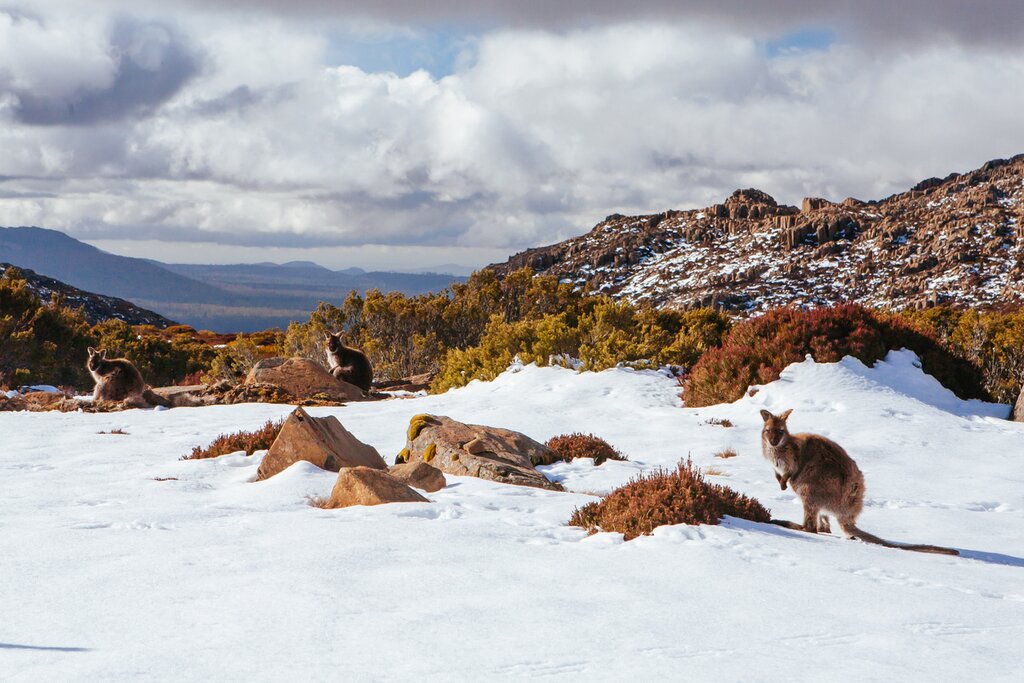Weather
Much of the south of Australia gets quite cold in the winter. Even places that still experience warm daytime temperatures in July can get very cold at night, such as the middle of the desert. Southern cities like Melbourne, Adelaide, Canberra, and Hobart can get quite cold in July. Bring a warm coat and some sweaters. Canberra regularly sees winter temperatures below 32°F (0°C) overnight, rising to 53°F (12°C) during the day. Most other southern cities are a bit warmer, with Melbourne and Adelaide experiencing average highs in the high 50s Fahrenheit.
Despite being south of their respective coasts, Coastal Sydney and Perth are pretty mild in July, with daytime highs around 65°F (18°C). In the outback, in places such as Alice Springs or Uluru, you can still expect pleasantly warm temperatures in the day, with highs of around 66°F (19°C), but temperatures drop significantly at night. As for rain, Sydney sees less rain in July than in June, but you can still expect some showers. Perth is quite wet, as spring and summer are the drier months in southern Western Australia. Other southern cities are much drier in July, and you won't experience much rain in Melbourne, Adelaide, Canberra, or Hobart.
Northern parts of Australia get almost no rain, as this is the middle of the dry season in the tropical north. Darwin remains hot, with average highs of 86°F (30°C) and lows of 68°F (20°C). But there's practically no rain here in June, July, or August. Humidity is at a low, which most travelers will find more comfortable. Northern Queensland towns are a bit cooler but still warm: Townsville, for example, has July highs of 77°F (25°C), with little rain.
Southern Queensland—such as Brisbane and the Gold Coast—is not tropical, and temperatures are lower in July (expect highs of around 68°F/20°C in Brisbane), but still pleasant and sunny, without much rain.
Crowds & Costs
July is peak season in the tropical north but not in the south. Flights to Australia tend to be cheaper in the winter, but those around Australia won't necessarily be. Book long-distance travel as far in advance as you can. Hotels and resorts in the north, especially at popular destinations like the Whitsundays, are more expensive at this time of year. Those in the south won't be.
Schools tend to take mid-winter holidays in early July for a couple of weeks (these sometimes start in late June). Australians from the south often like to travel north to escape their winter, so you'll likely encounter many domestic tourists in July, especially during the July school holidays.
Where to Go
Where to go in Australia in July largely depends on the kinds of experiences you want to have. If you enjoy hot weather and want to spend time on the beach, head to northern Queensland or Western Australia. To explore the outback and its fantastic national parks, head to the Northern Territory. If you want to go skiing or experience colder weather, venture to the mountains in southern New South Wales, the Australian Capital Territory (Canberra), Victoria, and Tasmania. For city sightseeing and indoor attractions like galleries and museums, Melbourne, Sydney, Brisbane, and Adelaide are great options.
Chat with a local specialist who can help organize your trip.
What to Do
Conditions are ideal in July for an outback road trip. From Adelaide, you can head west to Perth or up to Darwin via Uluru and Alice Springs. Alternatively, start in Brisbane and head northwest through the Queensland outback to Uluru or Darwin. Other road trips are also good at this time of year, such as along the coast of Queensland, between Brisbane and Cairns, or part of the way. The Great Ocean Road along the coast of Victoria is also possible this month, although temperatures will be cool there.
While Australia doesn't have the biggest mountains in the world by any means (its highest is Mount Kosciuszko at 7,309 ft/ 2,228 m), it does offer some decent skiing in the mountains of the southeast, as well as Tasmania. Ski fields in Tasmania, New South Wales, Victoria, and the ACT tend to operate from mid-June.
If you want to lounge on a beach, head to northern Western Australia or northern Queensland (Northern Territory beaches are generally a no-go because of the presence of crocodiles, but this varies by season, so check local conditions first). The Whitsundays and Port Douglas are the most popular areas in Queensland, while Western Australia is much more remote.
Events in July
Coonawarra Wine Festival, South Australia. Wine enthusiasts may want to head to South Australia, where the Coonawarra wine region (southeast of Adelaide and just north of Mount Gambier) holds a month-long wine festival.
Yulefest and Christmas in July, Nationwide. Christmas falls in mid-summer in Australia, and some locals feel that they miss out on the cozy, snow-flecked Christmases of the Northern Hemisphere. "Christmas in July" events are held throughout the country. In the Blue Mountains west of Sydney, Yulefest is an enjoyable event.
Traveling to Australia in July? Check out these great itineraries
Exploring Northern Australia - 9 Days. Explore the natural beauty and diverse wildlife of the northern half of Australia, making your way from tropical Cairns to lively Perth on this nine-day trip.
Ultimate Australia - 16 Days. This well-rounded 16-day tour of Australia's highlights will delight any first-time visitor. You'll sample the greatest sights and activities that Australia offers.
More Helpful Information
Australia in June
Australia in August
Best Time of Year to Visit Australia
How Many Days to Spend in Australia
